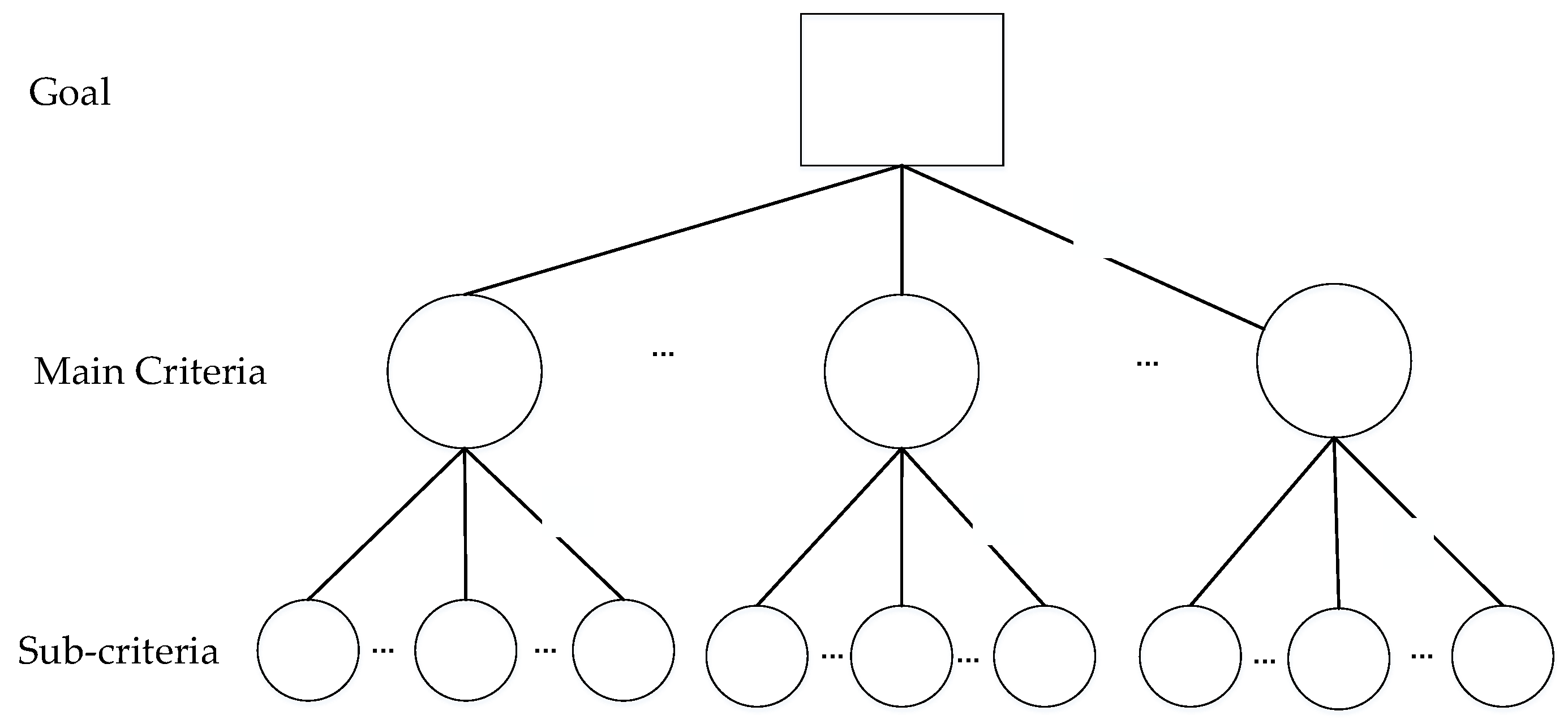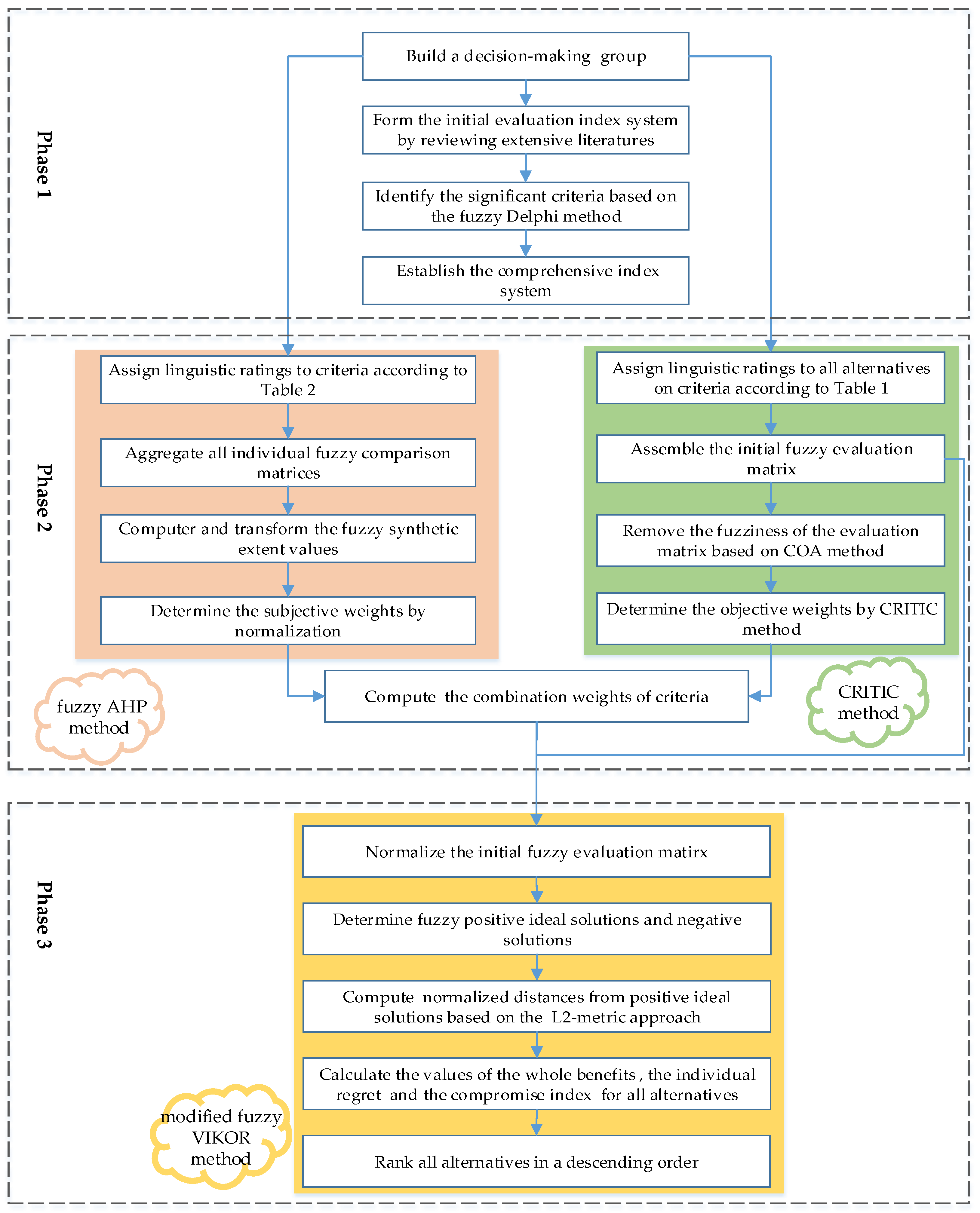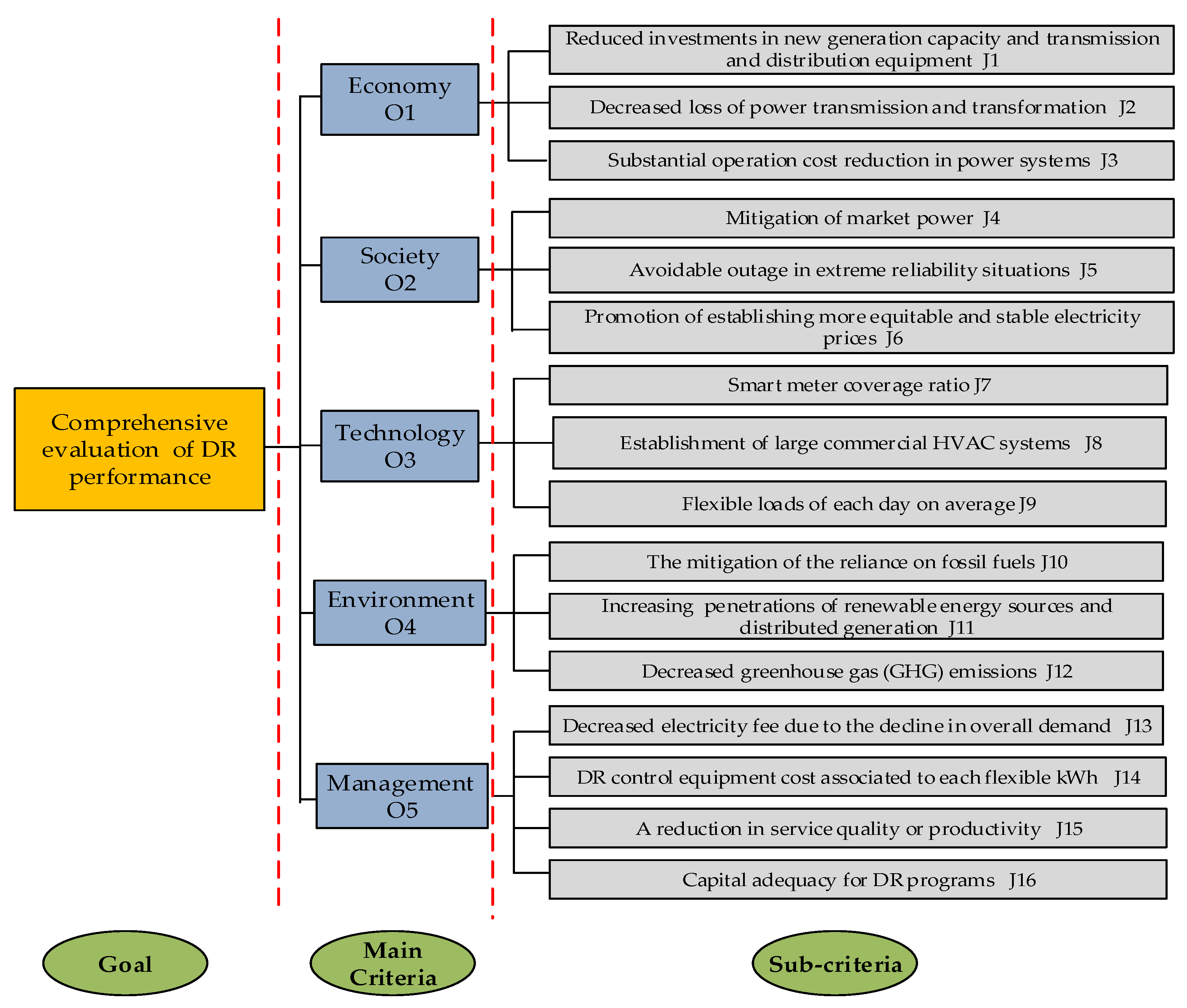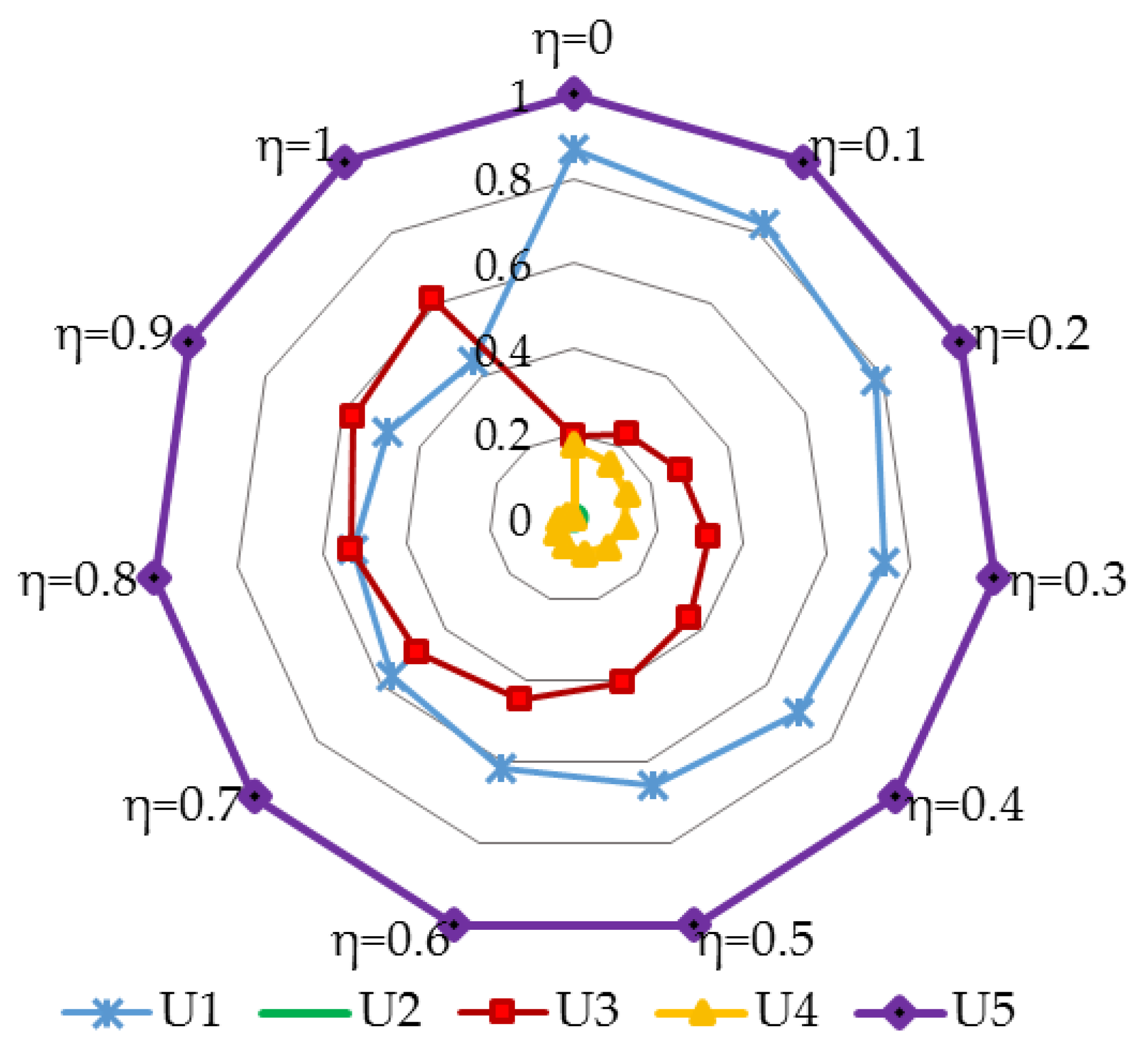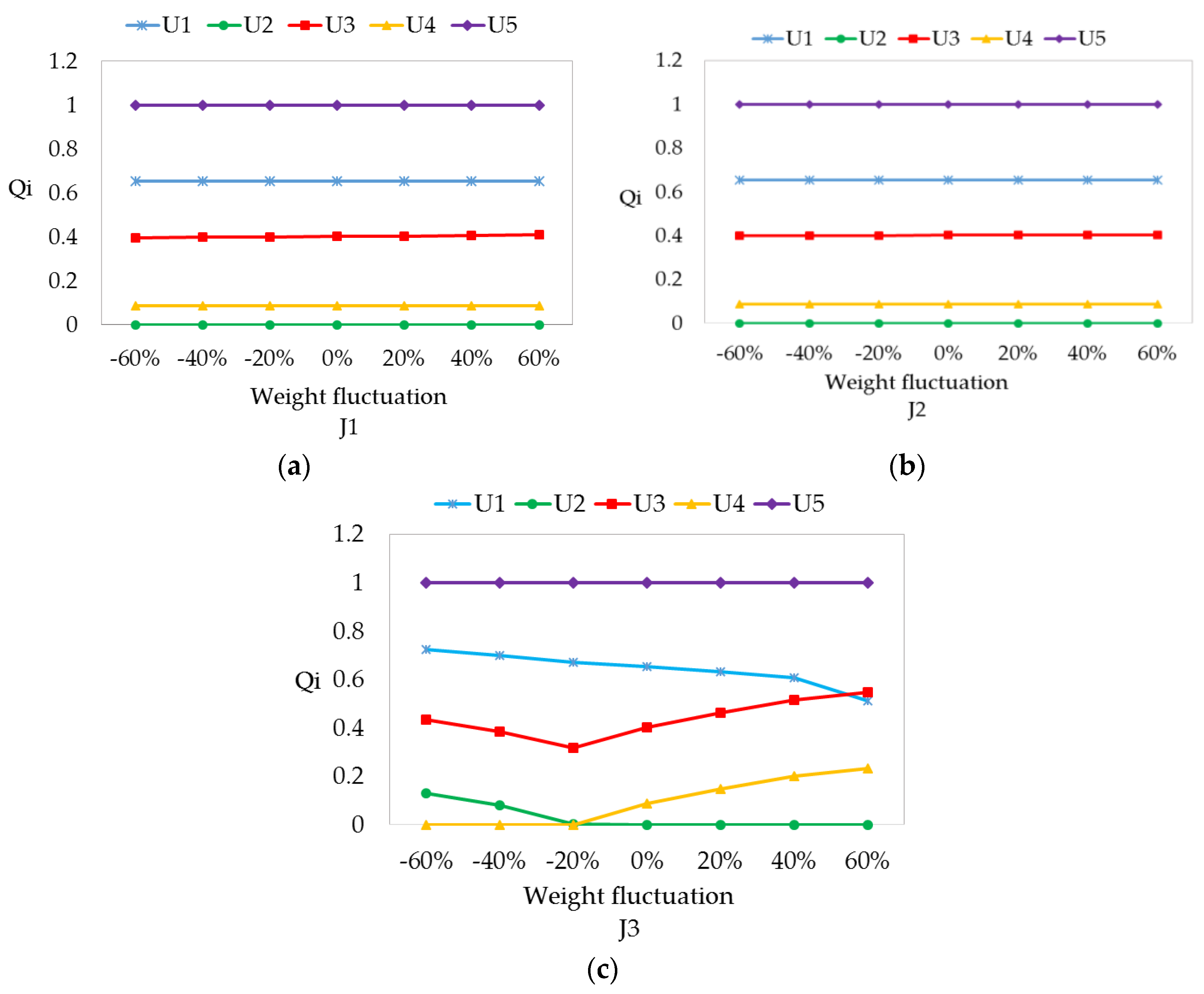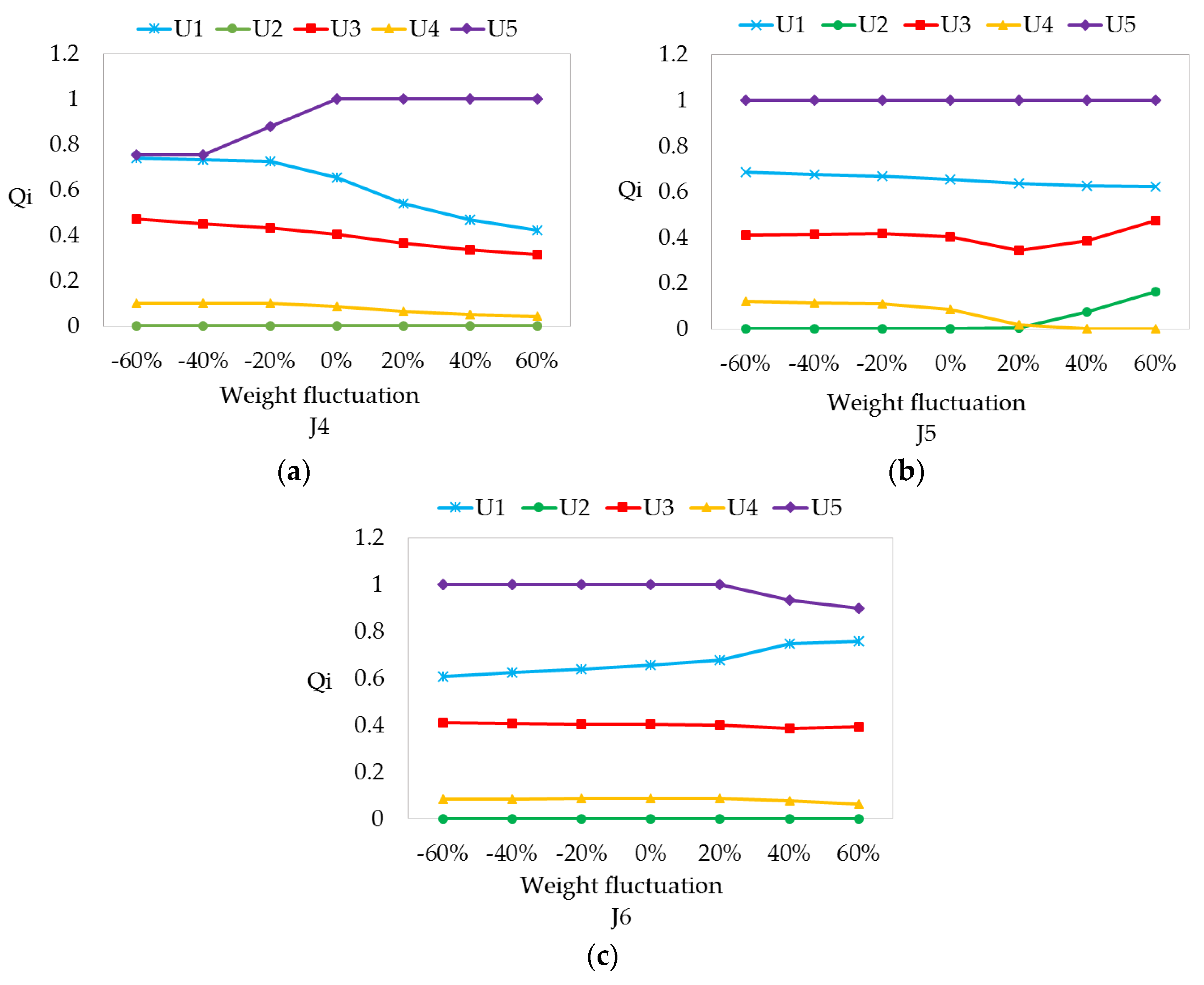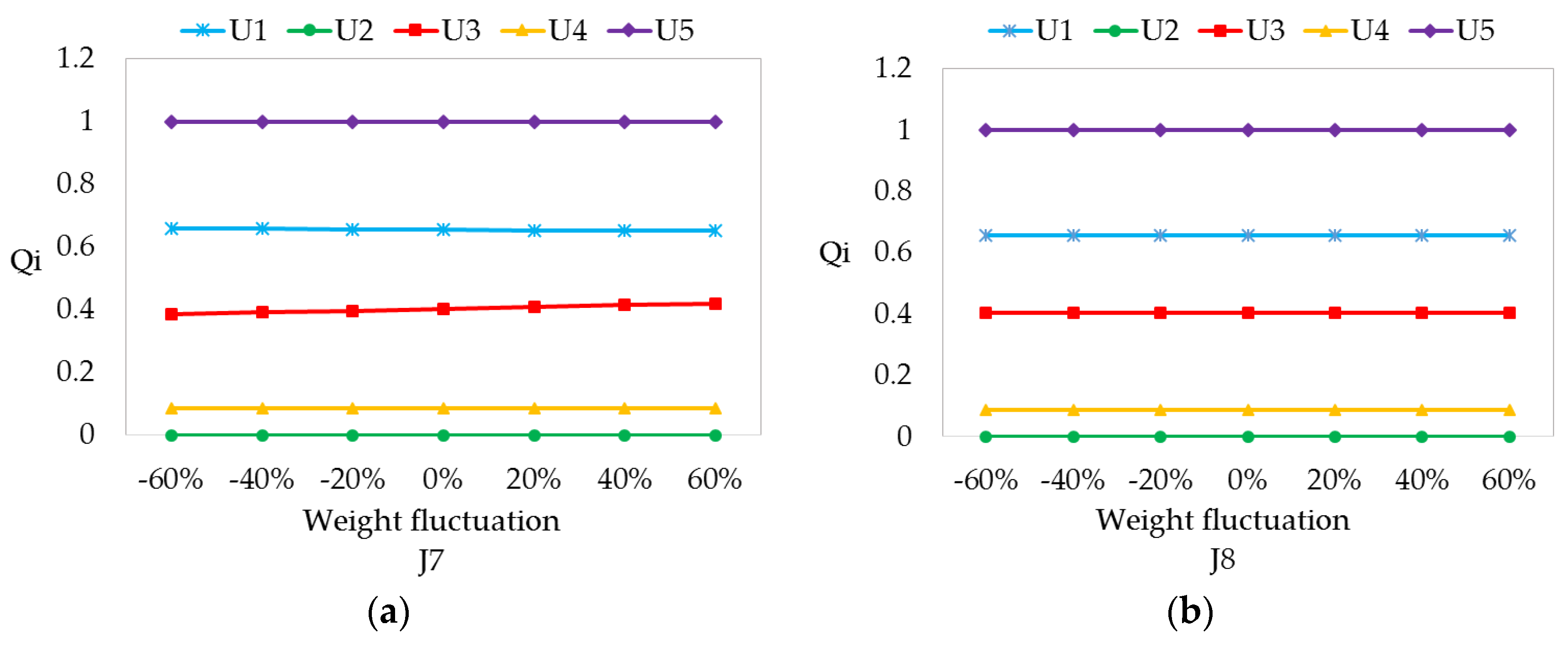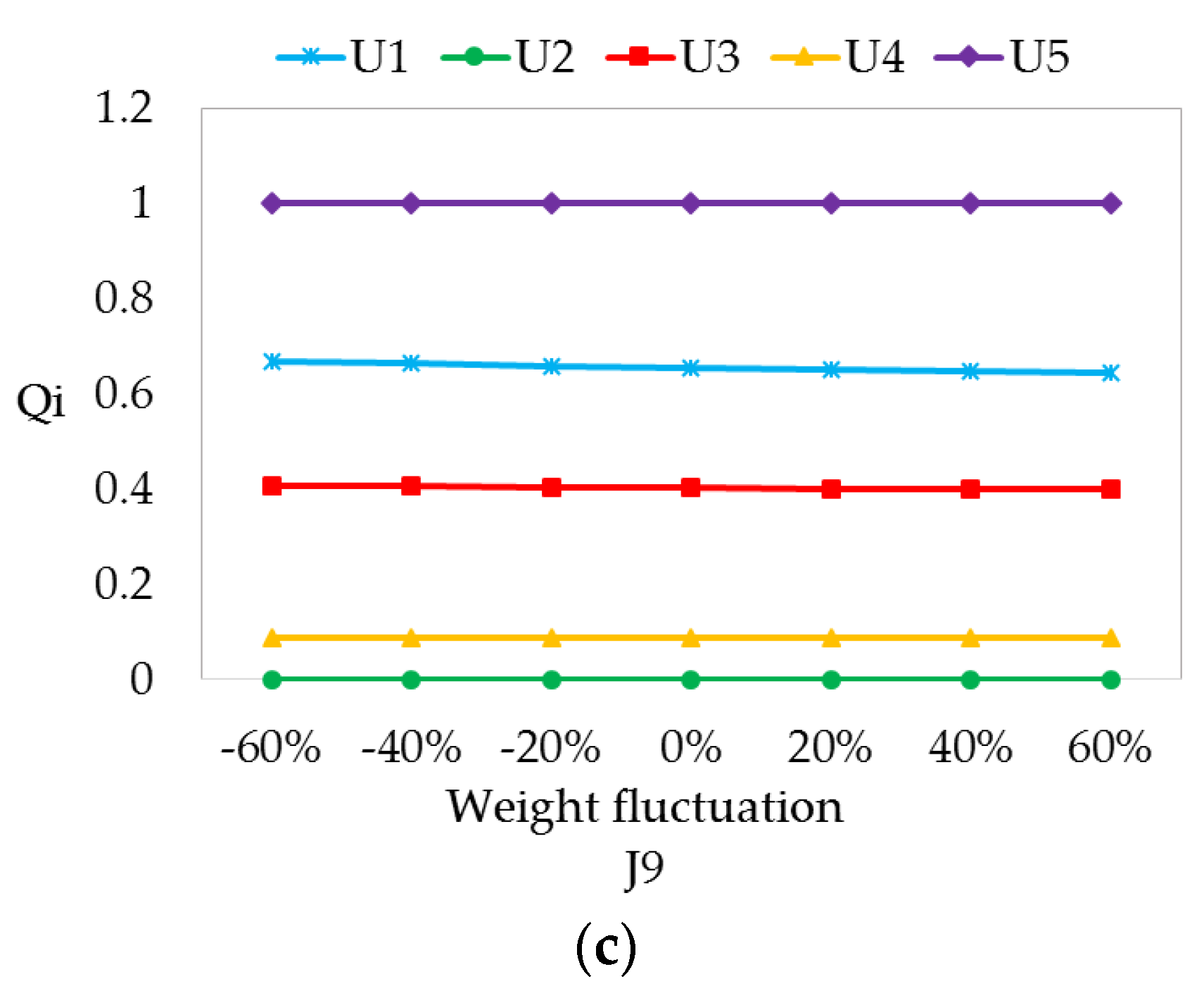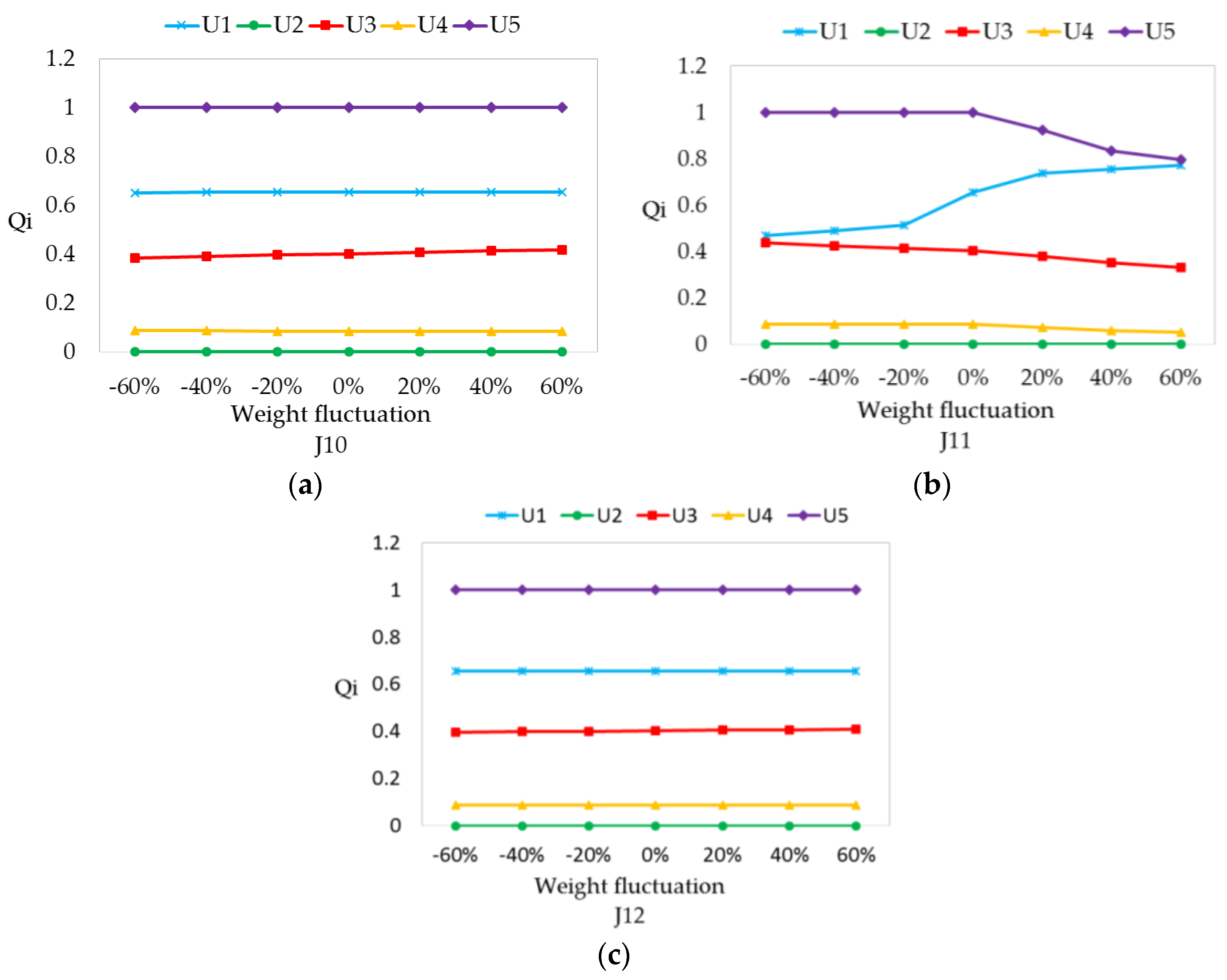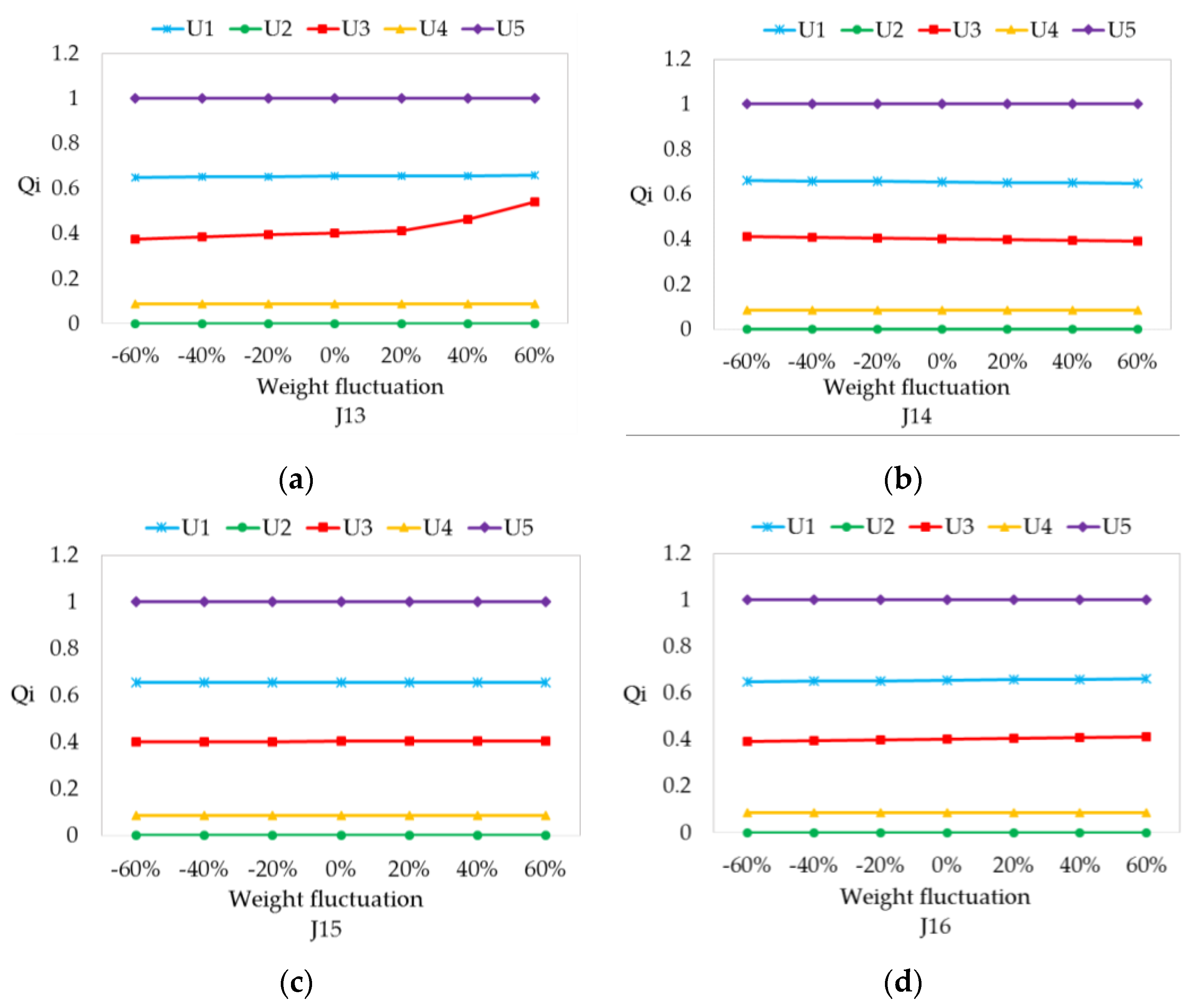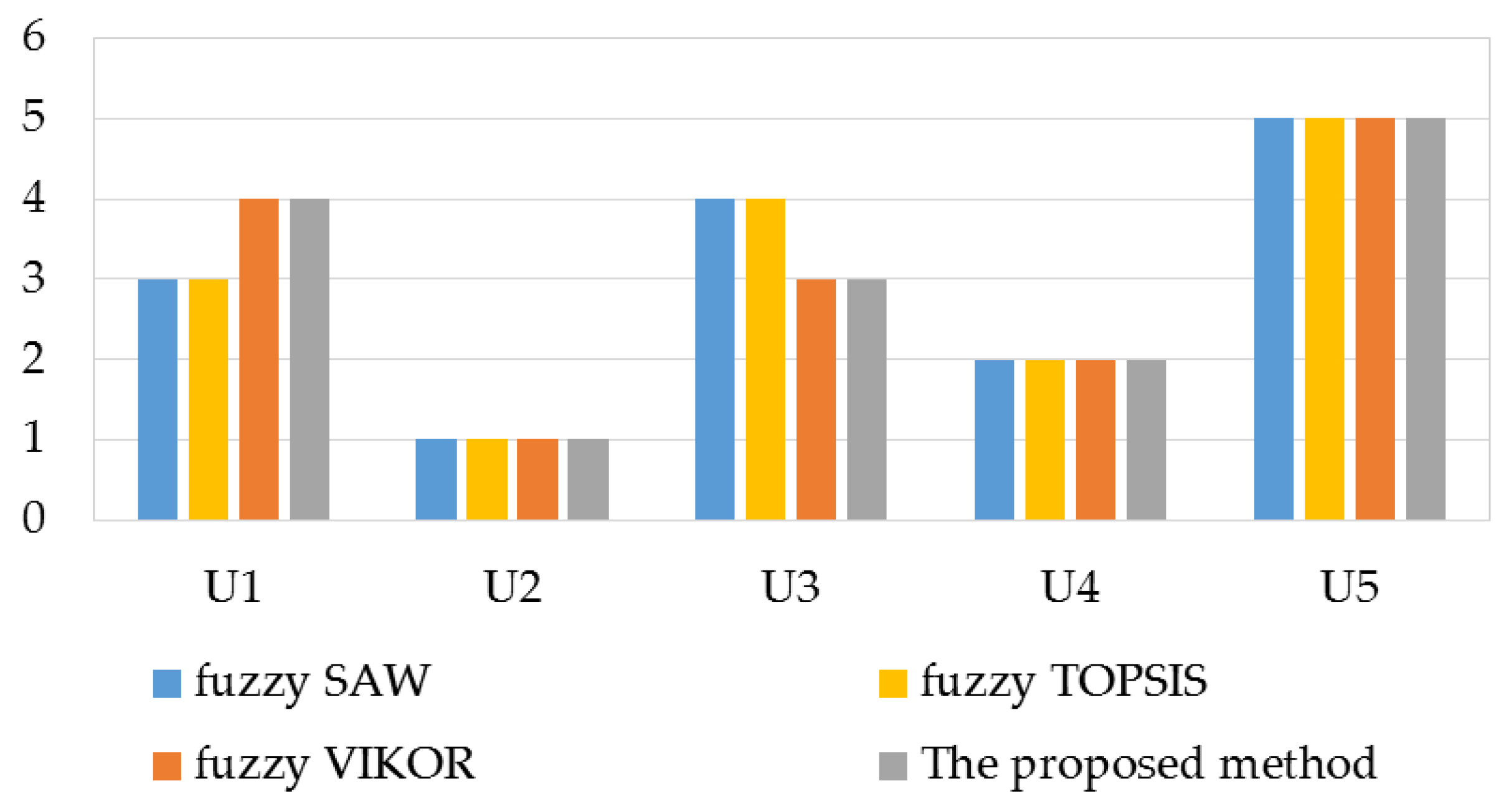1. Introduction
Conventional power industries relying heavily on fossil fuels have caused increasing environmental ecological issues worldwide, such as pollutant emissions, greenhouse effect, water quality degradation and fog and haze weather [
1]. With a growing consensus of sustainability development, renewable energy sources (RES) are introduced into power systems to replace depleted fossil fuels and realize energy transition, which are recognized as a global trend of power industries. China, for example, committed to increase a proportion of RES power generations to around 40% by 2020 [
2]. However, a lot of uncertain RES power generations, especially wind and solar, may lead to potential imbalances between supply and demand on power systems [
3,
4]. In order to process the problem, flexibility at the demand side is recommended to introduce into the power grids as more as possible. Demand response (DR) can lead to variations in energy consumption habits of users in response to different electric prices over time or in the presence of economic incentives. It is increasingly regarded as an elegant solution to compensate these imbalances and improve energy efficiency [
5,
6]. Massive potential flexible resources can be aggregated to reduce peak loads and handle the variability of RES power generations [
7]. Moreover, DR is an essential ingredient to decrease traditional power generations by adjustment of electricity demand and utilization of flexible resources [
8,
9].
DR programs have been researched and implemented widely in the industrial and commercial sectors worldwide [
10]. For instance, many DR programs in the United States were provided by the New York Independent System Operator in which participants can change their loads based on price fluctuations or emergency signals [
11]. In Europe, various DR programs were studied or put into practice [
12,
13], such as in the cases of Germany [
14], Sweden [
15], the United Kingdom [
16] and Italy [
17]. Torriti [
13] summarized the researches on these programs in the above European countries, containing DR status quo, economic potential and policy levels. In China, the National Development and Reform Commission announced the “Electricity Demand-side Management Measures” in 2010, which aimed to promote the DR programs in the industrial sector [
18]. Many regions were selected as pilots to conduct such programs with the support of special financial funds since 2012, including Suzhou, Beijing, Foshan, Tangshan and Shanghai cities [
19]. Following the industrial structure adjustment, commercial customers have been strong electric consumers and can account for the major increment of Chinese final electricity consumption. A lot of commercial flexible resources in lighting, electronic equipment, heating-ventilation and air conditioning (HVAC) systems should play a significant role in maintaining electricity balances and offering a series of options for demand management [
20]. Thus, many DR programs should be designed and performed for commercial users to control the flexibility through deploying smart meters widely, such as time-of-use tariff mechanisms, demand side bidding and interruptible load management [
21].
It is noted that implementing DR programs needs not only deployment of required automated devices, but also a thorough evaluation of their performance. In order to support decisions, it is essential to provide insight into the performance of these programs. Some researchers have already analyzed these assessments on some countries and regions, such as Conchado [
22] for Spain, FERC [
23] for the USA, Klaassen [
24] for Netherlands, Cepeda [
25] for France. Pinson [
7] offered an overview of the benefits and challenges for DR programs from the perspectives of operation, plans, economy, market regulations and business cases. Nolan [
26] summarized the DR evaluation methodologies from the aspects of production cost simulation and capacity value assessment. Previous researchers paid much attention to the DR performance in energy system operation, economic feasibility and environment protection, including energy cost saving [
22], flexible load aggregation [
27], peak load reductions [
28], the potential profits for project participants [
29], RES penetration [
30] and CO
2 emissions [
31]. Gils [
32] assessed demand response potential of the 40 European countries in all consumer sectors, involving shiftable loads, temporal availability and geographic allocation for flexible loads. However, these relevant researches with a few criteria are still relatively insufficient to reflect DR performance completely. It is essential to establish an evaluation system to measure the comprehensive performance of DR programs reasonably.
For comprehensive evaluation, a sustainable perspective is introduced to develop the evaluation system of DR performance. Based on a traditional sustainability paradigm, it should contain three dimensions: economic, social and environmental [
33]. Because the flexible resources of commercial customers are more dispersed than these of industrial users, massive elements on technology and management should be properly considered at the basis of relevant electric consumption processes. These elements may impact on customers’ response extremely, containing automated equipment construction and operation, technical standard implementation, a loss of productivity, prior experiences [
32,
34]. Hence, a comprehensive evaluation index system can be formed to reveal the performance of commercial DR from five dimensions, namely economy, society, technology, environment and management. An initial index system can be built firstly according to existing literatures. In order to ensure the rationality of the evaluation index system, a fuzzy Delphi method can be applied to remove redundant criteria according to experts’ linguistic ratings.
In view of the fact that the performance evaluation of DR involves many dimensions, a multiple criteria decision making (MCDM) technique should be proposed to conduct the evaluation processes. A variety of MCDM methods have been applied to assess the performances of enterprises or projects, such as the entropy weight method [
35], the analytic hierarchy process (AHP), the technique for order preference by similarity to an ideal solution (TOPSIS) [
36] and the elimination et choice translating reality (ELECTRE) [
37]. Based on previous research, we introduced a hybrid MCDM technique to the performance evaluation of commercial DR programs. Vlsekriterijumska Optimizacija I Kompromisno Resenje (VIKOR) method, put forward by Opricovic firstly [
38], has been regarded as a compensatory aggregation approach to handle discrete MCDM issues with conflicting and noncommensurable criteria. This method focuses on proposing acceptable compromise solutions closed to the ideal state and sorting a set of evaluation alternatives, which has been widely applied to simply multi criteria of complex decision systems and handle the balance between the overall benefits and individual satisfaction in real MCDM issues [
39,
40,
41]. However, experts often fail to provide precise decision makings for criteria performance due to lack of experience and accurate data. The decision making information, such as important, poor, good and so on, is almost impossible to describe through conventional quantitative expressions. To process vague decisions, a fuzzy VIKOR method was developed at the basis of a fuzzy logic theory [
42,
43,
44]. Linguistic ratings given by decision makers were expressed as triangular fuzzy numbers (TFNs) to perform calculations. Then to better effectively calculate distances between TFNs as well as sort priorities of alternatives with precise numbers, a L2-metric distance approach was applied to modify the traditional aggregating function. Moreover, a combination weight technique based on fuzzy AHP and Criteria Importance Through Intercriteria Correlation (CRITIC) methods was developed to promote the weighting determination processes for the fuzzy VIKOR.
Primary contributions in this paper are:
A comprehensive index system for DR performance in the commercial sector was formed firstly, including the five perspectives of economy, society, technology, environment and management. The fuzzy Delphi method with easy implementation was applied to select rational evaluation criteria based on decision makers’ opinions.
A hybrid MCDM model were established firstly to assess the comprehensive performance of commercial DR. A modified fuzzy VIKOR method with L2-metric distances was firstly developed. The fuzzy AHP and CRITIC methods were combined to innovate the weighting determination. Due to the application of the fuzzy logic theory, this model may effectively capture fuzziness of human decisions. The modified fuzzy VIKOR with the characteristics of clear concepts can measure precise distances between TFNs to better process conflicting criteria in complex decision-making systems. The combination weight technique not only contains decision makers’ judgments, but also utilizes objective information for all alternatives. It can ensure the rationality and practicality of weighting determination.
Considering that decision makers with diverse professional backgrounds may give different judgments, we conducted a set of sensitivity analyses to verify the impacts of criteria weights and parameter fluctuations on performance evaluation results. The detailed discussions can illuminate the robustness of the proposed framework under various cases. This is the first study that analyzes the important of evaluation criteria for commercial DR performance by changing the weights. The analysis results can contribute to help experts’ decision makings on DR programs.
The remainder of this paper is organized as follows.
Section 2 describes the basic methodology; the research framework is presented in detail in
Section 3;
Section 4 establishes a comprehensive evaluation index system for commercial DR performance. In
Section 5, an empirical analysis is illustrated by carrying out the DR performance assessment of five commercial buildings in China. We perform sensitivity analyses and discuss the results in
Section 6. Conclusions are drawn in the final section.
2. Methodology
We introduce relevant mathematics methods briefly, including the fuzzy logic theory, the fuzzy AHP, the CRITIC and the modified fuzzy VIKOR methods, which will be employed to propose a hybrid research framework.
2.1. Fuzzy Logic Theory
The fuzzy logic theory, introduced by Zadeh [
45] in 1965, is used to cope with vague linguistic information from human decisions in a real world. Fuzzy sets are defined to map ambiguous linguistic ratings into precise numerical terms. A fuzzy set is featured by a membership function with continuous grades. Each criterion can obtain a membership value among [0,1] to express its degree belonging to the fuzzy set. If a membership value is one, the criterion belongs to the set absolutely. If a membership value is zero, the criterion doesn’t belong to the set. If a membership value is between zero and one, the criterion belongs to the set partially. Besides, some linguistic ratings such as “poor”, “fair” and “good” can be described as a series of numerical intervals.
A TFN, denoted by a triplet
, is used widely in fuzzy applications.
and
are the minimum value, the middle value and the maximum value, which are all crisp numbers and
. Let
x be a vague variable, then its membership function
can be expressed as:
Suppose
and
are TFNs, some basic operations are:
The distance between
and
can be computed easily based on the L2-metric distance approach, which can better consider the different importance of the minimum value, the middle value and the maximum value of a TFN [
46].
Human often make vague answers instead of accurate values in MCDM processes. Qualitative linguistic values and the fuzzy set theory are suitable to evaluate performances rather than traditional numerical methods under fuzzy circumstances. As we know, the fuzzy logic theory has been gathered into a lot of traditional MCDM methods, such as fuzzy AHP, fuzzy Delphi, fuzzy TOPSIS, and fuzzy VIKOR methods. At the aim of comparing alternatives and obtaining precise information, a center of area (COA) defuzzification method is introduced to compute a best non-fuzzy performance (BNP) number [
47]. Let
be a TFN, its BNP value
is:
2.2. Fuzzy Delphi Method
The Delphi method, put forward by Dalky and Helmer [
48], is an important expert survey technique with the merits of anonymous responses, controlled and iterative feedback and statistical group responses. In order to make a consistent judgment, decision makers can get feedback information and revise previous opinions by several rounds of written communications. The traditional method has been widely used in economic forecasting, management strategy evaluation and public policy analysis etc. However, in terms of processing uncertain decision information, it has many shortcomings, such as long feedback time, high decision cost, low convergence rate, the possibility of distorting experts’ opinions. Thus, the fuzzy logic theory is introduced by Murry [
49] to improve the traditional method. The fuzzy Delphi method allows experts to express their opinions thought linguistic variables and has the following benefits compared with the traditional method: (a) Subjective judgments are reserved entirely to prevent distortion of decision results. (b) Consistent comments may be received by one round of a questionnaire survey instead of multiple rounds of modifications, which is considered to improve decision efficiency. Thus, the fuzzy Delphi method is applicable to recognize vital evaluation criteria for commercial DR performance. Calculation procedures are shown as:
Step 1: Collect opinions on evaluation criteria importance. Decision makers should give judgments on the relative importance of the m criteria, which is represented by several numerical intervals ranging from 0 to 10. 0 and 10 mean “extremely unimportant” and “extremely important”, respectively. The maximum of the numerical interval denotes optimistic cognition, whereas the minimum one denotes pessimistic cognition.
Step 2: Assemble several optimistic TFNs and pessimistic TFNs to reveal overall decisions. The maximum and minimum values of the number interval for each criterion are sorted out respectively. Their corresponding geometric mean values are computed. Then an optimistic TFN and a conservative TFN for criterion j can be assembled. and are the minimum values of optimistic cognition and pessimistic cognition given by all decision makers respectively. and are the maximum values of optimistic cognition and pessimistic cognition. and respectively correspond to the geometric mean values of all decision makers’ optimistic cognition and pessimistic cognition.
Step 3: Check the consistency of all decision makers’ opinions. A consensus significance value is introduced to determine a consistent degree of each criterion j. The larger the value is, the more consistent the opinions are. It can be calculated by:
Step 4: Choose vital criteria by setting a threshold . The value can be determined by the decision makers to reflect a minimum level of the acceptable consistency. If is lower than , the criterion j will be eliminated from an evaluation index system.
2.3. Fuzzy VIKOR Method
Conventional VIKOR method is usually employed for multi-criteria optimization of complex systems. Its obvious characteristics are that a multi-criteria ranking index is defined based on the special measurement of closeness to ideal points and the proposed compromise solutions offer the balance between maximization of whole utility and minimization of individual regret [
50]. Its basic idea lies in building an aggregated function that can reveal distances from the positive and negative ideal points. In order to cope with subjectivity and uncertainty of decision makings, the fuzzy logic theory is posited into the conventional VIKOR. The fuzzy VIKOR is much more rational to rank various alternatives including conflicting criteria in a real decision environment. In this section, the L2-metric distance approach is introduced to modify the normal aggregated function.
Assume that there are
m alternatives,
n criteria and
K decision makers in a MCDM issue. Each alternative is evaluated with relative to the
n criteria. Considering imprecision and uncertainty of subjective opinions, decision makers assess criteria performance based on linguistic variables in
Table 1. Let
be the fuzzy performance of the alternative
i with respect to criterion
j given by decision maker
k,
,
and
.
More procedures of the modified approach are shown as:
Step 1: Establish an initial fuzzy decision matrix.
These fuzzy ratings of alternatives should be aggregated as:
where
,
and
.
Then a MCDM issue can be presented concisely in a fuzzy matrix by assembling these aggregated fuzzy ratings, as is:
Step 2: Standardize the initial fuzzy decision matrix.
At the aim of avoiding criteria dimensional differences, it is vital to normalize the aggregated rating values. An evaluation index system usually contains benefit-type criteria with the higher the better and cost-type criteria with the lower the better. The linear scaling transformation method [
52] is applicable to transform the aggregated ratings into comparable format. Let
denote a normalized fuzzy decision matrix. The normalization processes are as below.
For a benefit-type criterion
For a cost-type criterion
Step 3: Define the fuzzy positive ideal solutions and negative ideal solutions for all criteria.
In order to obtain the comparative sequences of all alternatives, the fuzzy positive ideal solution
and negative ideal solution
with respect to each criterion can be defined as:
where
and
.
Step 4: Compute normalized distances from the positive ideal solutions.
where
denotes the normalized distance of alternative
i on criterion
j to the positive ideal solution
. It is worth highlighting that the L2-metric distance approach is introduced to improve the normal formula of fuzzy VIKOR.
and
can be obtained according to Equation (6).
Step 5: Compute whole benefits
and individual regret
for each alternative
where
is the weight of criterion
j. The
value implies the maximization of the whole benefits. The lower the
value is, the larger the whole benefits are. The
value implies dissatisfaction of individual criteria performances. The lower the
value, the less the individual regret.
Step 6: Determine the compromise index
for each alternative.
where
,
,
and
.
denotes the weight of the strategy of the maximum whole benefits, whereas
is the weight of the individual regret strategy.
Step 7: Sort the alternatives by comparing , and .
All alternatives should be sorted by the values in a deceasing order. The lower the value is, the more optimal the related alternative is. Moreover, only the following conditions are satisfied, the alternative with the minimum value is a top priority.
(i) Acceptable advantage:
where
and
is the first and the second alternatives ranked by
.
m is the number of evaluation alternatives
(ii) Acceptable stability in decision making:
The alternative must be the best sorted by and in a decreasing order. This compromise solution is steady in decision making processes, which could be “voting by majority principle” (), “by consensus” () or “with veto” ().
If the above two conditions are met simultaneously, is the best alternative. If one of the conditions are not met, a set of compromise solutions are developed, including:
and , if the second condition is not met, or
, ,…, , If the first condition is not met; is defined by the relation for the maximum value m.
2.4. Combination Weight Technique
To enhance decision weighting accuracy for the modified fuzzy VIKOR, combination weights are recommended based on subjective and objective methods, which involves subjective judgment and objective information comprehensively. The fuzzy AHP method is introduced to determine subjective weights based on decision maker’s comments. On the other, the CRITIC approach is proposed to obtain objective weights according to criteria performances.
2.4.1. Fuzzy AHP Method for Subjective Weights
Analytic Hierarchy Process (AHP), proposed by Saaty [
53], is a useful tool to clear complex interactions among criteria. A hierarchical structure of the AHP is often applied to divide a MCDM problem into sub-problems, which can be handled easily. This conventional approach has been considered as a useful method to determine criterion weights based on subjective judgments. Due to uncertain decision making, the fuzzy AHP with linguistic variables is more suitable to compute criteria weights than the conventional one. Moreover, TFNs are often introduced to map fuzzy linguistic ratings into quantitative data. Thus, the fuzzy AHP with TFNs will be applied to calculate subjective weights.
Let
be a main criterion set,
be a sub-criterion set. According the fuzzy AHP, a hierarchy structure should be built firstly. It contains the evaluation goal to be achieved at the top level, followed by the main criteria and sub-criteria to accomplish the goal, as shown in
Figure 1. Upon forming the hierarchy, pairwise comparison judgments with TFNs can be obtained from selected experts’ judgments according to Chang [
54], shown in
Table 2. Let
and
represent the pairwise comparative judgments of expert
k with TFNs at the main criteria layer and the sub-criteria layer,
and
. The following procedures are:
Step 1: Form individual fuzzy comparison matrices at each layer.
In order to understand relative importance of the criteria, the pairwise comparison judgments are aggregated as the individual fuzzy matrices with symmetric. Arithmetic rules should be complied in the following process: if
,
is equal to the TFNs in
Table 2. If
,
is (1, 1, 1,). If
,
is the reciprocal of these TFNs according to Equation (5). There is an example of an individual fuzzy comparison matrix
given by expert
k at the sub-criterion layer.
Step 2: Check the consistency of individual comparison matrices.
The fuzzy elements in the individual matrices should be mapped to crisp BNP numbers using Equation (7) at first. Consistency ratio (CR) is introduced to test the consistency, as is:
where
CI is a consistency index and RI is a random index. Let λ
max be a largest eigenvalue of a fuzzy matrix,
CI is
The RI values for different matrix orders are shown in
Table 3. The lower the CR value is, the more consistent the matrix is. Experiential threshold 0.2 is usually recommended as the upper limit for CR of a fuzzy comparison matric [
55]. If the CR value is less than 0.2, the matric is consistent approximately.
Step 3: Determine and transform fuzzy synthetic extent for each criterion.
In order to estimate the relative weights, the individual comparison matrices are aggregated according to an arithmetic average method. Let
and
be elements, the aggregated fuzzy comparison matrices at the main criteria layer (
) and the sub-criteria layer (
) are:
where
and
.
Let
be the fuzzy synthetic extent at the main criteria layer, it is:
where
,
,
Similarly, the fuzzy synthetic extent
at the sub-criteria layer is:
where
,
,
. In order to remove the fuzziness,
and
should be transformed into BNP values
and
.
Step 4: Compute normalized weights for all criteria
Consequently, the main criterion weight
and the sub-criterion local weight
can be obtained through normalization, as are:
According to the hierarchy structure, the normalized global weight
for sub-criteria is:
2.4.2. CRITIC Method for Objective Weights
Criteria Importance Through Intercriteria Correlation (CRITIC), proposed by Diakoulaki [
56] in 1995, is a technique to determine objective weights of relative importance for criteria in many areas, such as engineering, economic, management and so on. The objective weights are derived based on contrast intensity and conflict in MCDM issues, which contain not only the criterion standard deviations among alternatives, but also the correlations of various criteria [
57]. The method is suitable to be employed as an objective weighting decision technique in MCDM processes. Suppose that there are
m alternatives and
n criteria in a MCDM issue. Then an initial decision making matrix
X is:
Specially, for fuzzy MCDM problems, the decision making matrix containing fuzzy numbers should be transformed as BNP values based on Equation (7). Then the objective criteria weights can be obtained according to the following processes.
Step 1: Compute standard deviation
of each column vector
to measure criterion contrast intensity among different alternatives, as is:
where
is the mean value of criterion
j on all alternatives. The greater the
values are, the more obvious the divergence degree of the various alternatives.
Step 2: Determine the correlation coefficient
between different column vectors
and
to quantify the conflict resulted from criteria
j and
k. According to Pearson correlation coefficient,
is defined as:
It can be known that the more inconsistent the performances of criteria
j and
k, the lower the
value. Thus, the conflicting performance of criterion
j associated with the rest is measured as:
where the stronger positive correlations between criteria
j and the others, the lower the conflicting performance.
Step 3: Integrate the contrast intensity and the conflicting performance to measure comprehensive decision information for each criterion through:
Step 4: Determine the normalized weights of all criteria by:
2.4.3. The Combination of Fuzzy AHP and CRITIC Weighting Methods
As mentioned above, subjective and objective mathematical techniques are introduced to determine criteria weights simultaneously. Let
be subjective weight determined by the fuzzy AHP and
be objective weight determined by the CRITIC method. The combination weight
can be obtained in accordance with multiplicative synthesis, as is:
3. The Research Framework for the Hybrid MCDM Model
The integrated MCDM model is developed to evaluate the comprehensive performance of DR programs. Criteria weights are determined firstly by the combination weighting technique on the basis of fuzzy AHP and CRITIC methods. Then the alternative performances can be evaluated using the modified fuzzy VIKOR approach. The detailed evaluation procedures involve the following three phases, as shown in
Figure 2.
Phase 1: Identify evaluation criteria to form a comprehensive index system based on the fuzzy Delphi method.
In the first phase, experts in the research fields of DR are invited to form a decision-making group. At the aim of descripting the performance of commercial DR from a comprehensive perspective, an initial index system is built by reviewing extensive literatures. Then, considering commercial DR features and experts’ opinions, significant criteria are selected to constitute a comprehensive evaluation index system by applying the fuzzy Delphi method. In addition, evaluation alternatives are confirmed.
Phase 2: Determine the aggregate weights of evaluation criteria based on fuzzy AHP and CRITIC methods.
At the basis of the comprehensive evaluation index system, the evaluation criteria are weighted by aggregating subjective weights and objective weights. For the subjective weights determined by the fuzzy AHP, relevant experts are asked to assign linguistic ratings to the evaluation criteria based on the linguistic variables (
Table 2). Then, the consistencies of all individual comparison matrices are checked and all the matrices are aggregated. After computing and transforming the fuzzy synthetic extent values, the subjective weights can be obtained by normalization. For the objective weights determined by the CRITIC approach, vague linguistic ratings with respect to all alternatives on criteria are expressed by TFNs in
Table 1. Then the initial fuzzy evaluation matrix is assembled and defuzzified through the COA method. The subjective weights can be determined by calculating the values of
,
and
. On the basis of the above results, the aggregate weights for all criteria can be eventually obtained through multiplicative synthesis.
Phase 3: Assess comprehensive performance of the DR alternatives using the modified fuzzy VIKOR method.
In the last phase, the initial fuzzy evaluation matrix in the second phase is normalized firstly to eliminate the criterion dimension differences based on the linear scaling transformation method. Next, a series of fuzzy positive ideal solutions and negative solutions are determined. Then, the L2-metric approach is recommended to compute the normalized distances from positive ideal solutions. Finally, all evaluation results are calculated and all alternative performances are ranked in a descending order based on the values , and .
The research framework of the proposed hybrid evaluation model based on the fuzzy Delphi, the combination weighting and the modified fuzzy VIKOR methods has the following four advantages in evaluating the comprehensive performance of DR. First, the application of the fuzzy logic theory may capture the fuzziness of human decision making. Second, employing the fuzzy Delphi method to select the evaluation criteria can reflect DR performance reasonably from multiple perspectives based on experts’ opinions. In addition, the combination weighting technique can integrate subjective and objective information to determine criteria weights, which also innovate the weighting determination process of conventional fuzzy VIKOR. Last, the modified fuzzy VIKOR is capable to efficiently handle vague decision making processes and the conflicting criteria existing in the performance evaluation. Therefore, the hybrid MCDM model is much more applicable to cope with real world issues.
6. Findings and Discussions
We sorted the performances of the five DR programs by applying the combination weights and modified fuzzy VIKOR methods. Their ranking results in a descending order are U2, U4, U3, U1 and U5. The best alternative is U2 and the second one is U4. The above results imply that this proposed research framework can effectively evaluate and chose a best alternative to implement DR programs. Meanwhile, according to the
Table 19, sub-criteria J4, J11 and J6 affiliated with society and environment main criteria get much more attention from expert groups, which reflect the goals and strategies of Chinese governmental apartments in electricity market construction and environmental protection. While the sub-criteria affiliated with economy and technology main criteria are not so important. As we all know, the electricity sector in China faces serious challenges from the “thirteen five-year” plan and an electricity market reform in 2015. The fact implies the target of the electricity industry for social responsibility and environment protection [
60]. Competitive electricity market mechanisms are gradually being established to promote energy conservation and pollution reduction [
61]. Therefore, the society and environment dimensions have been fully taken into account by experts for the DR performance evaluation in China.
In order to validate the stability and rationality of the framework and research results, a series of sensitivity analyses for parameter
and criteria weights are conducted. First, the weight parameter for maximum overall benefits
is used from 0.0 to 1.0 increasing by 0.1 to reveal the impacts on final ranking results. The results are graphically presented in
Figure 4. The final rankings of the five alternatives are shown in
Figure 5. The best is still alternative U2, followed by U4. This study confirms that the ranking results determined by the proposed framework are effective and reliable.
Then a set of sensitive analyses on the impacts of criteria weights are conducted to obtain better insight of raking results and prove the robustness of these results. Sixteen sub-criteria affiliated in five main criteria have 20%, 40% and 60% more weight than the base weights and 20%, 40% and 60% less weight than the base weights. These base weights are presented in
Table 19.
For the weight variations of sub-criteria in the economy main criterion, the
values of the five DR programs have small changes, no matter how the sub-criteria J1 and J2 change (
Figure 6.). Moreover, as the weights of J3 decreases, the
values and rankings of U2 and U4 change obviously. It is seen that J3 is a sensible sub-criterion. However, no matter how the weight changes in the economy main criterion, U2 and U4 are still optimal alternatives.
Figure 7 presents the cases of the sub-criteria weight fluctuations in the society main criterion. As J4 is more important, the
of U1, U3 and U4 are decreasing, while the value of U5 is increasing. With the increasing weight of J5, the
for U2, U3 and U4 are apparent variations and the sorting of U2 and U4 is inverted. Except for U2, the other values are changed in different degrees along with the weight fluctuation of J6. No matter how the sub-criteria weighs in the society main criterion change, U2 and U4 are priority choices. In addition, all the sub-criteria affiliated with the society main criterion are sensitive to weight fluctuations.
For the sub-criteria in the technology main criterion, the
of the five alternatives remain stable as the corresponding weights increase, which indicate that sub-criteria J7, J8 and J9 are stable (
Figure 8).
The cases in which the weights of three sub-criteria fluctuate in the environment main criteria are presented in
Figure 9. As J10 and J12 are more important, the values
for all alternatives are tiny fluctuations. The
values have obvious variations along the weight of J11 increases. U1 and U5 get closer and closer significantly, which is similar to the trend of U2 and U4. However, no matter how the weights in the environment main criterion, U2 always keeps the supreme in the DR performance evaluation.
For the sub-criteria in the management main criterion, the
value of U3 presents an increasing trend along with J13 becomes more important (
Figure 10). While in the cases of weight fluctuations of J14, J15 and J16, the
of the five alternatives hold a small variation trend. Just as that in the technology and environment main criteria, the final ranks of these five alternatives keep relatively stable, even though J13 carries a large weight in DR performance evaluation.
At the basis of the above analysis results, it is seen that the proposed method can effectively chose a best alternative. Moreover, to prove its validity, we applied the above cases to compare the results of the proposed method with the other comparable methods, including fuzzy simple additive weighting (SAW), fuzzy TOPSIS and previous fuzzy VIKOR methods. The fuzzy SAW approach, put forward by Chou [
62], is to obtain a series of weighted sums of the performance ratings for all alternative. The fuzzy TOPSIS method, proposed by Chen [
63], is that the selected alternative should present the shortest distance from the positive ideal values and the farthest distance from the negative ideal values. The previous fuzzy VIKOR method, developed by Kim [
64], is used to find out compromise solutions based on differences of the fuzzy numbers rather than their precise distances. Here, the weights for the maximum overall benefits in the previous fuzzy VIKOR and the proposed method are set to 0.5. The linguistic ratings for all criteria performances listed in
Table 16 and the base weights presented in
Table 19 are uniformly applied to the four methods.
Table 24 and
Figure 11 show the analysis results. It is found that U2 and U4 are the best and the second choices in the three comparable approaches, which are consistent with the proposed method. The raking orders of the five alternatives using the fuzzy VIKOR and the proposed framework are the same.
Reference standards for criteria performances aren’t considered in the fuzzy SAW, which may result in an unconvincing ranking order. Although the fuzzy TOPSIS have contained the concept of ideal points, the weighting difference between positive and negative ideal values is ignored in the synthetic processes of each alternative performance. When an alternative is regarded as the top choice determined by the fuzzy TOPSIS, it does not mean that the alternative is always the closest to the ideal points. For the previous fuzzy VIKOR, the connection between alternatives and ideal points are defined as the uncertain differences between the corresponding TFNs, which have multiple feasible operations. For the proposed method, we introduced the precise L2-metric distances to determine the differences between alternatives and ideal points.
7. Conclusions
A hybrid framework for evaluating the performance of DR programs in the commercial sector was developed in this paper, which can efficiently promote the operation management of DR. In view of the sustainable development concept and commercial DR program features, an evaluation index system for performance evaluation of such programs was established, including five pillars: economy, society, technology, environment and management. The fuzzy Delphi method was recommended to select final evaluation criteria scientifically based on experts’ opinions. In order to cope with the fuzziness of human decisions and conflicts of evaluation criteria, the modified fuzzy VIKOR containing the L2-metric distance was applied to assess the comprehensive performance of the commercial DR. The method can not only grasp the vagueness in available information as well as the uncertainty of subjective judgments, but also solve the direct ranking of fuzzy numbers with respect of evaluation alternatives. In addition, in order to ensure a scientific weighting determination system, the evaluation weights were computed by integrating the subjective weights of the fuzzy AHP and the objective weights of the CRITIC, which replaced the weighting procedure of traditional fuzzy VIKOR. The hybrid framework with clear calculation processes was proven feasibly and effectively in the empirical study. The analysis results show that the sub-criteria J4, J11 and J6 affiliated with society and environment main criteria get much more attention from expert groups. To verify the robustness and effectiveness of evaluation results, a set of sensitivity analyses were performed, which presents that U2 and U4 always remain respectively the first and the second preferences along with criteria weight fluctuations and value changes. Finally, a comparative study was conducted to demonstrate that our proposed framework can be used to determine the alternatives rankings and the priorities of improving criteria of weak alternatives.
There are still some limitations existing in the evaluation index system. Considering policy changes and electricity market development, we must timely update the evaluation criteria for commercial DR programs. The proposed framework will be performed again based on a new index system in order to track the DR evolutions. In our further study, we will test the proposed framework with other techniques from a methodological perspective. Moreover, the results from these techniques will be compared with the results in this paper to better overcome fuzziness in group decisions.
